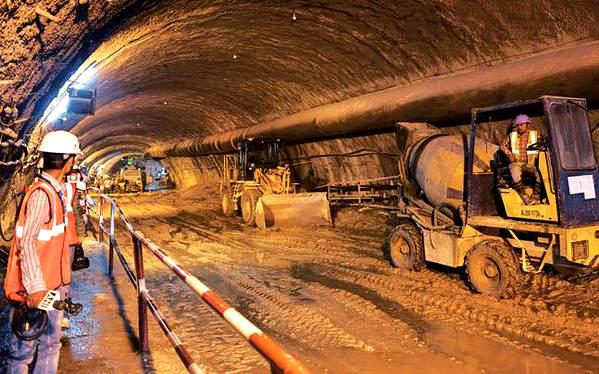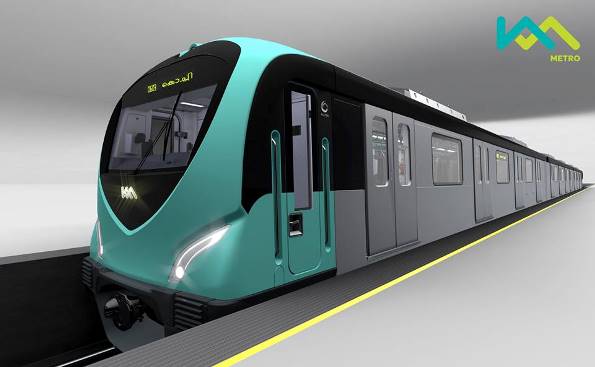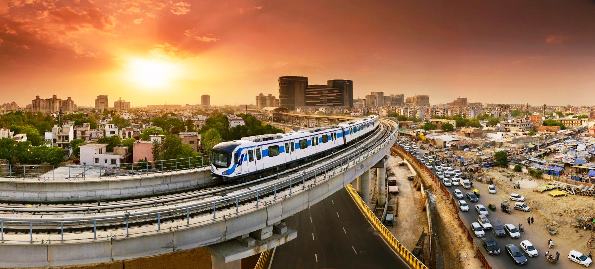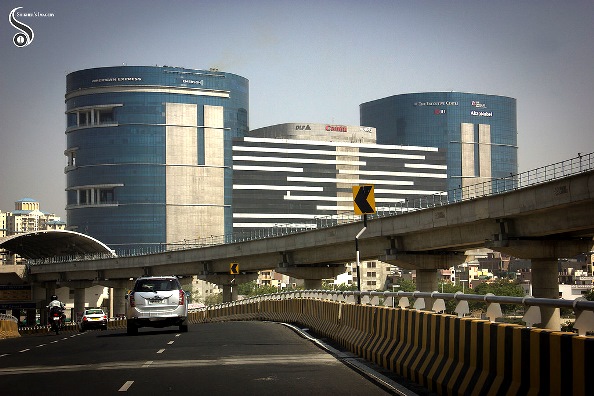TBM tunneling direction:

Link to update: http://themetrorailguy.com/2015/09/02/b ... ing-update

wasn't this too close to the corner pillar?Rohit_K wrote:A TBM quietly made a breakthrough at Chennai's AG-DMS/Gemini station from Teynampet yesterday. With this, the tunnels between Saidapet to Gemini are complete.
[img]https://scontent.xx.fbcdn.net/hphotos-x ... e=567F4D00
Exactly! No one believed me when I pointed this out couple of pages back.vsunder wrote: Delhi Metro is partly to blame for the woes of Bangalore Metro. DMRC was fully pre-occupied with the CWG games and did an improper DPR for Bangalore Metro. For example they recommended only 2 TBM's, and of the wrong type. There is a pointed exchange on record between Srisailam, former MD before Kharola of Bangalore Metro and Sreedharan. Bangalore Metro had to re-work the nonsensical DPR provided by DMRC. In the end 5 TBM's( east ramp was done by a TBM rented from Delhi metro) were employed and NATM( New Austrian Tunneling method) for the west ramp. Also it looks like the geo-technical survey was improperly done. .....
http://civil.iisc.ernet.in/~microzonati ... /NCW-3.pdf

Rohit_K is right, just one nit-pick, its a chord *not* diameter of the circle. Hope this will be helpful:SaiK wrote:just asking.. a TBM job for dual track is more economical than tunneling for a single track?


True, but it just points to the complexity of the tunnel method itself. And there were reports that this pipe was one of the drilled pipes left over from the soil sample phase of this very project. If true, shows the kind of coordination that we bemoan of in Indic lands happens in khanate as well. Anyway, OT here.Hitesh wrote:It was stuck not because of the big machine itself but because it hit a large metal pipe that wasn't either disclosed to the tunnelers or was failed to be removed before the TBM reached its location.
Don't they also need to build cross tunnels for evacuation purposes? I understand that adds to the time *after* the TBM has tunneled and installed the concrete rings. And being the first underground section in Namma Metro, testing will take more time than subsequent ones, I would guess.vsunder wrote:Tunneling all this will take 6 months at a very, very optimistic level, the past is not very encouraging. After tunneling, Bangalore Metro takes 1.5 years to install rails, and the third rail and Signalling and telecom equipment in the tunnels.
Yes they have cross-passages every 300m on the East-West tunnels. The East-West tunnels were done a while back, March 18th 2014 was the final breakthrough on East-West tunnels. Since then they have been installing rails, the third rail and signalling equipment, fixing the stations etc. The West bound line is done. The East bound line, third rail installation is left on about 15% of track. The tracks are done. The hope is the trial runs will start in the UG section east-West in December. Trains will not stop at Majestic the Interchange between East-West and North-South lines as that station is far from complete. It will need approval from CRS for such train movement through an underground construction zone, which is the central hub of Namma Metro.arshyam wrote:
Don't they also need to build cross tunnels for evacuation purposes? I understand that adds to the time *after* the TBM has tunneled and installed the concrete rings. And being the first underground section in Namma Metro, testing will take more time than subsequent ones, I would guess.
I didn't read anything negative on the wiki except for env issues. I read 2019 deadlinearshyam wrote:^^ Ask the city of Seattle. They tried doing a double-decker road tunnel and the TBM gave up last year and hasn't recovered yet
Looks like the Chennai Metro one, but with a different coloured fascia. Are they both the same model ?Rohit_K wrote:Kochi Metro's rolling stock design has been released. The first coach will be delivered in 3 months
<snip inline pic for quote>
more views on the metro rail guy: http://themetrorailguy.com/2015/09/03/k ... o-unveiled
Cannot really be the same model. Kochi metro like Bangalore is third rail 750V DC, see my posts on regenerative braking in IR thread and DC opposed to AC. Chennai Metro is overhead wires 25KV AC with pantograph. Also note in the IR thread on CBC couplers that WAP-7 from RYP(Royapuram shed) had roof mounted rheostat brakers so that excess current can be dissipated away as heat through the resistance.Suraj wrote:Looks like the Chennai Metro one, but with a different coloured fascia. Are they both the same model ?Rohit_K wrote:Kochi Metro's rolling stock design has been released. The first coach will be delivered in 3 months
<snip inline pic for quote>
more views on the metro rail guy: http://themetrorailguy.com/2015/09/03/k ... o-unveiled
Does the Geology of Bengluru vary so much that they needed 2 different machines? I always thought that this was Dharwar Shield Craton and quite consistent. Just curious why this decision was made.vsunder wrote:Interestingly the East-West tunnels were cut using slurry TBM's Helen and Margarita, while the NS tunnels are being cut using EPB TBM's ( earth pressure balance machines).
450m from Mantri Mall, 60 feet under there lies a white snake:( Margarita stops at the granite wall it faces after doing well 600 m from Majestic)SaiK wrote:vsunder, what is "snakes of quartz" ?
Same suppliers as CMRL, so lots of commonalities.The Rolling Stock is being manufactured by Alstom India after they had won the bid to supply 25 train-sets each consisting of 3 cars in August 2014 quoting a price of Rs 633 crore. The 2.9m-wide 65m-long trains can accommodate up to 975 passengers with 140 of them seated. All 75 coaches are currently being assembled at Alstom’s Sri City plant in Andhra Pradesh
source: http://www.thehindu.com/news/national/k ... 613672.eceIt was a proud moment for the Bangalore Metro Rail Corporation (BMRCL) when their tunnel boring machine ‘Krishna’ emerged at the Chickpet Metro Station on Monday. However, for the private photographer who claimed that he was hired by BMRCL to document the event, it was a close shave as debris mixed with slush fell very close to him, and he was covered by it in no time. A few minutes after the incident, , the photographer was seen with his damaged equipment screaming at the safety engineers there. Site officials, clueless as to what to do, chose to just ignore the photographer after a while.
Namma Metro officials said they had not hired the photographer in question, and that there was no question of giving him compensation as the safety guidelines were clear in the email invite.


According to the supplier of Jaipur's TBM, The Robbins Company, Jaipur's TBMs came from Delhi -vsunder wrote:East-West and North South tunneling companies are different. Helen was sent to Jaipur. The other TBM's working in South Bangalore are Krishna and Kaveri.
source: http://www.therobbinscompany.com/wp-con ... letter.pdfAt the Jaipur Metro, Robbins is supplying two refurbished 6.65 m (21.8 ft) EPBs from previous tunneling on the New Delhi Metro.




Thanks for the update. As I had mentioned earlier and the Robbins site now confirms, once Krishna emerged at Chickpete after taking 20 months to tunnel 432m, Robbins has taken over the management of three TBM's Krishna, Kaveri and Godavari from the Indian company. I hope they infuse the right degree of professionalism for the remaining 2km of tunneling. CEC-Soma still controls Margarita, so now I am curious where Helen went after it finished at Bangalore. The arrangement is unusual, since Herrenknecht built the Earth Pressure Balance TBM's Kaveri, Krishna and Godavari, but now Robbins will take over the TBM's that were not fabricated by it and manage future tunneling operations on Bangalore Metro.Rohit_K wrote:According to the supplier of Jaipur's TBM, The Robbins Company, Jaipur's TBMs came from Delhi -vsunder wrote:East-West and North South tunneling companies are different. Helen was sent to Jaipur. The other TBM's working in South Bangalore are Krishna and Kaveri.
source: http://www.therobbinscompany.com/wp-con ... letter.pdfAt the Jaipur Metro, Robbins is supplying two refurbished 6.65 m (21.8 ft) EPBs from previous tunneling on the New Delhi Metro.